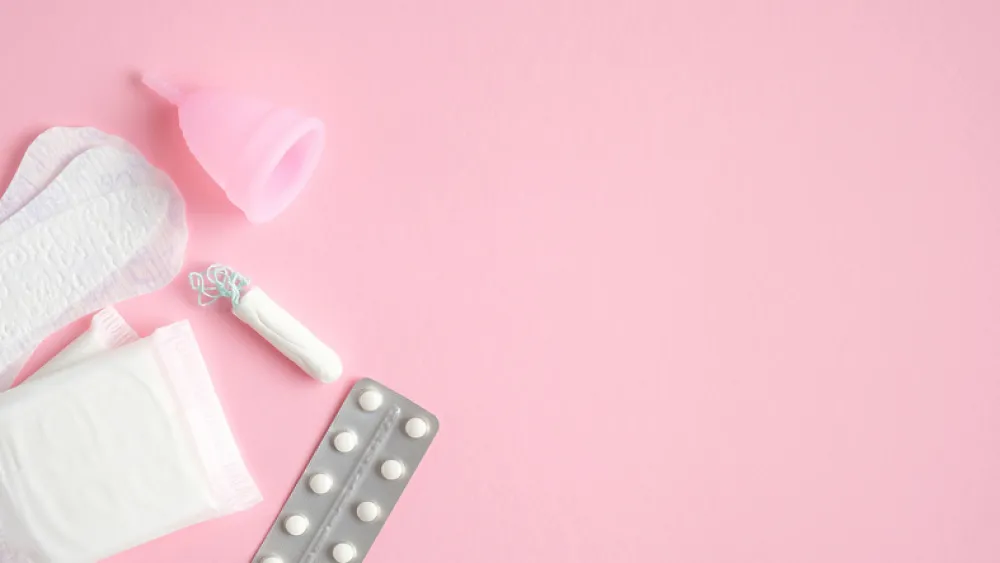




Women's Health
Period cycles, products and symptoms explained
Published: April 15, 2025

Some of the most alarming statistics surrounding menstruation come from the World Health Organization – that millions of females worldwide have little to no knowledge of menstruation and how to address or manage it prior to having their first period. This lack of education and preparation can lead to shame, fear, the inability to discuss the topic openly and poor menstruation health.
No girl should be put in a situation where they’re forced to take a guess on how to best care for themselves during their first period. So, let’s get to the basics and share more information just like this. Chances are likely that someone in your circle could benefit from one or more of the topics below.
What’s normal, what isn’t and when to see a health care provider
A woman’s menstrual cycle – or period – is a complex, hormonally regulated process that prepares the female reproductive system for potential pregnancy. It’s divided into the follicular, ovulation, luteal and menstruation phases.
Normal cycles consist of the following:
• A cycle that lasts between 21 and 35 days
• Menstrual bleeding that lasts between two and seven days
• Saturation of a pad in two to six hours
• Symptoms that include breast tenderness, abdominal bloating and mood changes
If you experience any of the following, reach out to a health care provider:
- Irregular cycles
If your cycles are shorter than 21 days or last longer than 35 days, or if you have fewer than eight cycles per year, you may have an underlying issue – such as polycystic ovary syndrome. - Heavy bleeding
If you experience heavy bleeding that requires changing your pad or tampon every hour, or if your period lasts longer than seven days, you should seek medical advice. - Painful periods
Severe menstrual pain that interferes with daily activities may be a sign of conditions like endometriosis or fibroids. - Amenorrhea
The absence of periods by age 15 or the absence of periods for three consecutive cycles in women who previously had regular cycles warrants evaluation. - Other symptoms
Symptoms such as severe mood changes, fatigue or signs of infection (unusual discharge, itching or odor) should prompt a visit to a health care provider.
It’s important to understand that there are special considerations when it comes to irregular cycles and flow, including:
- Adolescents
Menstrual cycles can be irregular in the first few years after periods begin. However, cycles that are consistently outside of the 21- to 35-day range should be evaluated. - Perimenopause
Women approaching menopause may experience changes in their cycle length and flow. However, persistent irregularity should be discussed with your health care provider.
Maintaining a menstrual diary can help track your cycle and identify any irregularities. Always reach out to your health care provider for personalized advice if you have any concerns about your menstrual health.
Period products and their safety concerns
When it comes to pads, tampons and the like, a quick walk down the personal hygiene aisle can feel overwhelming. What offers the best protection? Are all options safe?
Here’s a list of period products and the safety concerns attached to them:
- Disposable pads and tampons
Disposable pads and tampons are the most commonly used period products. Pads are worn externally and come in various absorbencies. Tampons are inserted into the vagina and also vary in absorbency.
Safety concerns
These products can contain volatile organic compounds (VOCs) and endocrine disrupting chemicals (EDCs). These chemicals may pose health risks through absorption in the skin. Tampons, in particular, are associated with the risk of toxic shock syndrome – a rare but life-threatening condition due to the growth of bacteria and its production of a toxin.
Additionally, scented products can cause allergic reactions on the skin.
- Menstrual cups
These reusable, bell-shaped devices made of medical grade silicone, rubber or latex are inserted into the vagina to collect menstrual blood. They are cost-effective and environmentally friendly. They also have high favorability rate among users. Cups are associated with fewer leaks compared to pads and tampons, and they have no significant adverse effects on vaginal flora.
Safety concerns
Generally considered safe, menstrual cups have been associated with a few adverse events, including severe pain, vaginal wounds, urinary tract complaints and rare cases of toxic shock syndrome. Cups also carry a risk of dislodging intrauterine devices (IUDs). Proper hygiene and usage are crucial to minimize these risks.
- Period underwear
Period underwear products are designed to absorb menstrual blood and can be worn alone or as back up protection. They are gaining popularity due to their convenience and sustainability.
Safety concerns
While specific studies on period underwear are limited, potential concerns include the presence of synthetic chemicals, which have been detected in other menstrual products and may pose reproductive toxicity risks. Ensuring the materials used are free from harmful chemicals is essential.
- Reusable pads
Made from fabric, these pads can be washed and reused, making them a sustainable option. They are particularly beneficial in low-resource settings where disposable products may be unaffordable.
Safety concerns
These are generally safe but can pose challenges related to hygiene – again, especially in low-resource settings where access to clean water and proper drying facilities may be limited. Skin irritation has been reported, but no significant infections have been documented.
While each menstrual product has some degree of safety concern, proper usage and hygiene practices can mitigate many of these risks.
General hygiene and safety tips
So what does proper hygiene look like? Here’s a list to get you started:
- Hand hygiene
Always wash your hands with soap and water before and after handling menstrual products. - Frequent changing
Change disposable pads and tampons every four to six hours to prevent bacterial growth and reduce the risk of toxic shock syndrome. Menstrual cups should be emptied and cleaned every 4 to 12 hours, depending on flow. - Cleaning
Wash menstrual cups with mild, fragrance-free soap and water, and boil them for five to 10 minutes between cycles to disinfect them. Reusable pads should also be washed with soap and water, dried thoroughly and stored in a clean, dry place. - Safe disposal
Throw away used disposable pads and tampons in a covered bin. Avoid flushing them down the toilet to prevent septic issues and environmental harm. - Personal hygiene
Wash the genital area with water and mild soap at least once a day. Avoid using scented products that can cause irritation. Change underwear daily, ensuring it is clean and dry.
Tips for symptom relief and pain management
Periods often get a bad rap – and largely because of the symptoms that can accompany them. Here are safe and effective tips for symptom relief and pain management:
- Nonsteroidal anti-inflammatory drugs
Ibuprofen (400 milligrams every four to six hours) and naproxen sodium (440 milligrams initially, then 220 milligrams every eight to 12 hours) are effective in reducing menstrual pain. - Hormonal contraceptives
Oral contraceptives, patches and vaginal rings can help regulate menstrual cycles and reduce pain by thinning the endometrial lining and decreasing prostaglandin levels. - Heat therapy
Applying a heating pad or hot water bottle to the lower abdomen can help relax uterine muscles and reduce cramping. - Exercise
Regular physical activity, including aerobic exercise – like walking or swimming – can improve blood flow and reduce pain. - Dietary supplements
Supplements such as vitamin B1, vitamin E and fish oils have shown some benefit in reducing menstrual pain. - Alternative therapies
Acupressure, acupuncture and transcutaneous electrical nerve stimulation (TENS) may provide relief for some individuals. - Lifestyle modifications
Maintaining a healthy diet, staying hydrated, and avoiding caffeine and alcohol can help manage symptoms. - Prescription medications
For severe pain, your provider may prescribe stronger medications or hormonal treatments.
If your symptoms don’t improve with these tips, reach out to your health care provider for further evaluation and management.
Common menstrual misconceptions
Menstruation is a natural part of life for many people. However, there are several misconceptions about menstruation that can lead to confusion and unnecessary worry. Here are some facts that address some of the most common myths:
Myth: Menstrual blood is dirty or impure.
Fact: Menstrual blood is not dirty. It is the same blood that circulates throughout the body, mixed with the shedding of the uterine lining. Menstruation is a natural process and does not make a person impure.
Myth: You should not exercise during your period.
Fact: Exercise is safe during menstruation. It can actually help reduce menstrual cramps and improve mood. Physical activity increases blood flow and releases endorphins, which are natural pain relievers.
Myth: You cannot get pregnant during your period.
Fact: While it is less likely, it is still possible to get pregnant during menstruation, especially if you have a shorter cycle. Sperm can live in the body for up to five days, so if you ovulate shortly after your period, pregnancy can occur.
Myth: Using tampons can cause infections or get lost inside of the body.
Fact: Tampons are safe when used correctly. They cannot get lost inside your body, as the cervix prevents this. However, it is important to change tampons every four to six hours to reduce the risk of infection/toxic shock syndrome.
Myth: Menstrual cycles should be exactly 28 days.
Fact: Menstrual cycles can vary. A normal cycle can range from 21 to 35 days. Variations are normal and can be influenced by stress, diet and other factors.
Myth: Menstrual pain is always normal.
Fact: While some discomfort is common, severe pain that interferes with daily activities may include a condition like endometriosis or fibroids. If you experience severe pain, consult your health care provider.
Myth: Hormonal contraceptives are harmful and should be avoided.
Fact: Hormonal contraceptives are safe for most people and can help regulate menstrual cycles, reduce pain and manage other symptoms. They do not harm long-term fertility.
Myth: Menstruation should be hidden and not discussed.
Fact: Menstruation is a normal bodily function and should not be a source of shame. Open discussions can help to address misconceptions and promote better menstrual health practices.
Understanding the facts about menstruation can help you manage your menstrual health more effectively. If you have any concerns or questions, don’t hesitate to reach out to your health care provider for personalized advice.
Remember, our happiest, healthiest life starts with education. Share some of it today.
More Resources
- Find an OB/GYN right for you.
- Learn more about Women’s Health services at Methodist.
- Read similar articles in our Women’s Health section.


